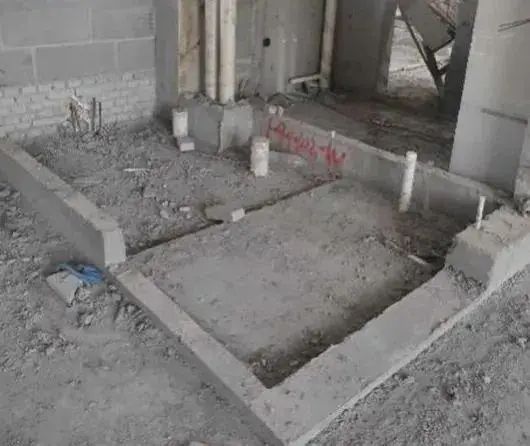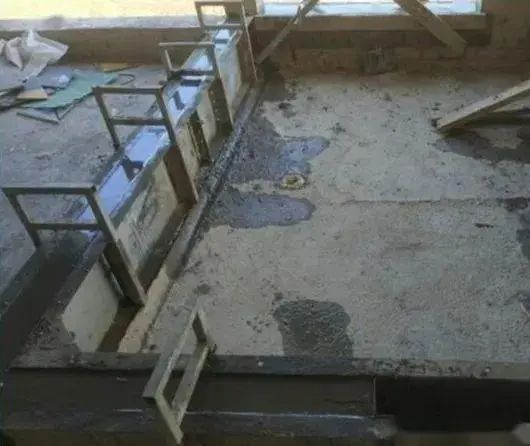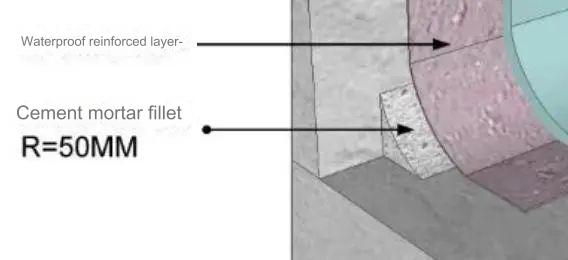1. What is a Bathroom Water Barrier?
A bathroom water barrier is a method designed to prevent water from seeping into interior spaces. It is poured simultaneously with the structural concrete and is also known as a water lip or water stop, with a height requirement of more than 150mm. This method is mainly used to waterproof the bathroom's base, a typical structure seen at many construction sites.

The purpose of installing a water barrier in the bathroom is to prevent water from leaking into the back of the walls. The principle behind this is to create an inward-sloping surface at the corners of the bathroom floor, causing the water to flow downward along the slope rather than seeping into the back of the walls. This effectively prevents moisture accumulation and leakage behind the bathroom walls.

In architectural design, concrete water barriers are a standard method to enhance the waterproof performance of bathroom floors, thereby avoiding leakage problems in the future. Other waterproofing measures can be adopted, such as applying waterproof coatings inside the bathroom walls or using waterproof panels. Regardless of the method, ensuring the bathroom's waterproofing is adequate to protect the residents' health and quality of life is essential.
Concrete water barriers can reduce the likelihood of water penetrating the walls, thereby preventing leakage problems. However, the construction of a water barrier can create a construction joint between the barrier and the floor, which could become a potential leak. Therefore, during the construction of the water barrier, it is crucial to strictly control the height, slope, and other parameters to ensure the compactness and stability of the contact surface between the barrier and the floor, avoiding any leaks in the construction joint.
Additionally, you mentioned the issue of waterproofing layer failure or damage at the bathroom corners, which is another significant cause of wall base leakage. Therefore, during bathroom renovations, attention must be paid to the quality of the waterproofing layer construction and the choice of materials. For existing leakage problems, the waterproofing layer and walls should be promptly repaired to prevent further damage.
In summary, bathroom water barriers are an essential measure to prevent leaks. However, potential issues with construction joints must be addressed, and the quality of the waterproofing layer construction and material selection must also be considered to ensure the waterproof performance of the bathroom wall base.
2. How to Properly Waterproof the Bathroom Wall Base?
To ensure that the bathroom walls do not deteriorate at the base, measures must be taken to prevent moisture infiltration and accumulation within the walls, which could lead to wall base decay.

Firstly, a waterproof layer and anti-crack structure at the corners need to be applied on the water-facing side of the wall (the side most exposed to water). Corners are where two walls meet, typically at the junctions. Water quickly accumulates in these corners, and if proper waterproofing is not applied, moisture will seep into the wall, causing decay at the base. Standard methods include using waterproof coatings and waterproof membranes to treat the corners.
Secondly, a moisture-proof layer must be applied to the water-averse side of the wall (the side facing away from water). Since bathrooms typically have high humidity levels, moisture will seep into the walls if moisture-proofing is not done, leading to decay at the base. Therefore, moisture-proofing treatments, such as moisture-proof coatings or membranes, should be applied to the water-averse side of the wall.
In conclusion, ensuring the bathroom walls do not decay at the base requires internal and external measures. This means applying a waterproof layer and anti-crack structure at the corners on the water-facing side of the wall, as well as a moisture-proof layer on the water-averse side. This approach prevents moisture infiltration and accumulation within the walls, avoiding wall base decay.




